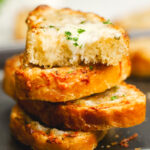Basic macaron recipe
This basic macaron recipe is perfect for beginners. In this post, you’ll find all my tips and tricks for perfectly full shells with pretty little feet and smooth tops, as well as my detailed video tutorial to walk you through the entire process!

Author: Sweetandsavorybyshinee/Photo credit to sweetandsavorybyshinee.com
Ingredients
- For macaron shells:
- ▢100 g super fine almond flour Note 1
- ▢75 g powdered sugar/confectioners sugar Note 2
- ▢70 g egg whites, at room temperature (about ⅓ cup)
- ▢75 g fine granulated sugar Note 3
- ▢¼ teaspoon cream of tartar optional (Note 4)
- ▢¼ teaspoon coarse kosher salt
- ▢Gel food coloring if desired
- For buttercream filling:
- ▢2 large egg yolks
- ▢¼ cup (50g) sugar
- ▢3 ½ tablespoons milk
- ▢½ cup (115g) unsalted butter, softened
- ▢1 teaspoon pure vanilla extract
- Note: I test all my recipes with both measurements for the most precise and accurate result!
Instructions
- To make macaron shells, line 2 baking sheets with parchment paper, or teflon sheet, or silicone mat. (TIP 1: For even air circulation, flip the baking sheets upside down.)
- To prepare dry ingredients, sift together almond flour and powdered sugar twice. Note: If you have up to 2 tablespoons of chunky dry ingredients left in the sifter, you don’t have to replace it. Simply discard those chunky bits.
- To make meringue, in a clean mixing bowl with a whisk attachment, beat the egg whites on medium low speed until foamy. (I set it to speed 2 or 4 on my KitchenAid stand mixer.)
- When egg whites are foamy, add cream of tartar and salt and continue to whisk.
- Then slowly add sugar one tablespoon at a time, while mixer is still running. Allow the sugar to dissolve after each addition.
- If you’re making colored shells, add gel food coloring when the meringue reaches soft peaks.
- Continue beating the egg whites on the same medium low speed until hard peaks form. Visual cues: Meringue should ball up inside the whisk, and when you lift the whisk, the meringue should hold a pointy end and have sharp ribs. (See pictures above or watch this meringue video for more information.)
- To make batter, sift almond flour mixture into the meringue. Using a silicone spatula, fold the dry ingredients into the meringue until fully incorporated. Then continue to fold the batter until it’s runny enough to draw a figure eight. To test, take a small amount of batter and drop it into the bowl. If the small peaks dissolve into the batter on its own in about 10 seconds, the batter is ready. If not, fold couple more times and test again. Be careful not to over-fold the batter. (TIP: Making french macarons is all about the technique. This is one of the most crucial step. Let me try to describe the folding motion as best as I can: run the spatula clockwise from the bottom, up around the sides and cut the batter in half. If you’re beginner macaron-baker, I suggest to count every fold. It takes roughly about 50 folds to reach the proper consistency. After 50 folds, start testing the batter, and continue testing after every couple folds.)
- To pipe macaron shells, transfer the batter into a pastry bag, fitted with a round tip. (I used this Wilton 2A tip.)
- Hold the pastry bag at straight 90° angle and pipe about 1.5-inch rounds about an inch apart on prepared baking sheets. (TIP 2: I made a perfect macaron template for you. Simply pipe the batter to fill inner circle.)
- Tap the baking sheets firmly on the counter (or using your hand) a few times to get rid of any air bubbles. You can also use a toothpick to burst some large air bubbles. This step ensures smooth tops.
- Let the macarons sit out on the counter for at least 15-30 minutes, maybe up to couple hours, depending on humidity. When you lightly touch the macarons and the batter does not stick to your finger, then it’s ready to go into the oven.
- Meanwhile, preheat the oven to 300°F (150°C). Note: I don’t use convection settings. I set my oven to heat from top and bottom.
- To bake, working one baking sheet at a time, place one tray with macarons on the middle rack. (TIP: To prevent browning, place an empty baking sheet on top rack to shield the heat.) Bake for about 15-18 minutes. It’ll take longer for larger macarons. To test for doneness, touch a macaron lightly and try to move it. If it slides and wobbles, bake a minute or so longer. The cooked macarons should be firm to touch and the base shouldn’t move. (TIP: It’s always better to slightly over-bake macarons than under-bake them!)
- Cool the macarons on the sheet for 10-15 minutes, and then transfer onto a wire rack to cool completely.
- To make the buttercream filling, in a medium bowl, beat the egg yolks slightly with a whisk and add sugar. Continue to whisk until the mixture is pale and sugar is mostly dissolved. Stir in the milk. Transfer the egg yolk mixture into a small saucepan and heat over low heat, stirring frequently. Continue to cook until it’s thick like pudding, about 5 minutes. Transfer the mixture back to the bowl and bring it to room temperature. Stir in the butter in three batches. Add vanilla extract and continue to mix until smooth. Transfer the buttercream into a pastry bag with round tip.
- To assemble macarons, pair the macaron shells by size and arrange them on a wire rack. Line them up so that bottom shells are upside down.
- Pipe a dollop of filling on bottom shells. Place the top shell over the filling and press lightly so the filling spreads till the edges.
- Store the filled macarons in an airtight container in the fridge for at least 24 hours to mature, which allows the filling to soften and flavor the shells.
- To serve, bring the macarons out about 30 minutes prior to serving.



